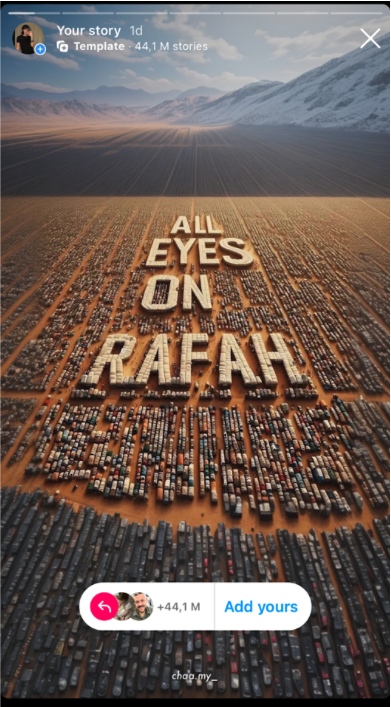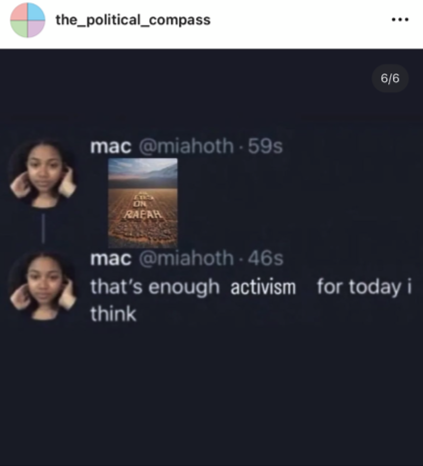You’ve seen it and you’ve probably shared it.
The AI-generated image figuring composed, symmetrical lines of refugee tents, seemingly snowy mountains gently emerging in the background, ‘All Eyes on Rafah’ in capital letters surfacing from white-coloured tents.
“Rafah looks nothing like that: Its skies are grey with smoke from Israeli bombs and there are no orderly rows of tents – many are smouldering after being bombed with their occupants still inside, and debris is scattered between them.” (Sarah Shamim, 2024)
You might have felt some anguish at the grotesque midjourney-coded aesthetic, or let out a sight of relief for the digestible imaginary referring to a slaughtering bombing. A question floats: what has drawn more than 44 million Instagram users, especially a vast majority of previously silent people, to reshare this template en masse?
It would not be a harsh discrediting of the artist (pointed out by Al Jazeera as IG user @shahv4012) to state that surely 44M people were not simply attracted by the aesthetic, let alone emotionally touched by it. It also didn’t provide a new slogan for the international movement. ‘All eyes’ were on Rafah since February 2024, as more than 2 million people were forcibly displaced there from Gaza and Israel announced an upcoming ground operation in Rafah. Already on April 3rd Amnesty International urged states worldwide to protect people in Rafah and take immediate action to implement a ceasefire, warning that (further) atrocities were bound to unfold. The text ‘All eyes of Rafah’ has been displayed on banners at protests, in news headlines, social media for weeks, and we have read the message repetitively since Israel started bombing Rafah on March 26, when it killed 31 people.

The viral AI-generated poster seems to have drawn unprecedented attention to Israeli genocidal attacks on Palestine, getting positive commentary alongside some thoughtful criticism.
It is indeed curious and somewhat heartbreaking that an incredibly impersonal, surreal, and hollow image could be the turning point in stirring and moving the international sentiment about the genocide in Palestine. In a private conversation, writer and editor @jawclenching defined this viral image as a possible “political tiding point”, as we reflected on what led to the enormous amount of reshares.
Coming as an ‘Add Yours’ template rather than a post, it is more easily reshared than other content formats, but can we really ascribe the virality of the post to laziness? Or better, do we want to?
As I wrestle to give further credit to users’ agentivity online, I can hypothesise that the vast majority of people appear withdrawn to share graphic content, if that content even comes to them in the first place. In fact, Meta platforms apply notoriously heavy censorship to ‘sensitive content’, and pro-Palestinian posts and stories have been subjected to an unashamed shadowbanning by the aforementioned enterprise, clearly privileging zionist rhetoric and impacting activists online.
As of today (29 May 2024), Instagram content is regulated by its Community Guidelines, which refer to Meta’s broader Transparency Center policies. Under ‘Violent and Graphic Content’ we read the following statement:
“To protect users from disturbing imagery, we remove content that is particularly violent or graphic, such as videos depicting dismemberment, visible innards or charred bodies. […]
In the context of discussions about important issues such as human rights abuses, armed conflicts or acts of terrorism, we allow graphic content (with some limitations) to help people to condemn and raise awareness about these situations.”
What the ‘some limitations’ are is currently unclear, but we know that Meta relies upon AI for content regulation purposes. As we observe the unfolding paradox of AI regulating AI, we can see that ‘All Eyes on Rafah’, empty of both graphic imagery and language, can easily sneak into everyone’s feed, overcoming the barriers that most of the genocide-related content usually faces.
Moreover, increased exposure to disturbing, gore, and graphic imagery can desensitize to violence, or conversely exacerbate a trauma-related response. The ‘All Eyes on Rafah’ image, now just as popularized as the black banner in support of the Black Lives Matter movement, can then cater to those users that grew either apathetic by the omnipresent violence of unfolding genocide(s), or the ones that have placed some forms of content filtering for self-protection.

Can we also argue that glossy AI images, still peaking high on online trends, intrigue a broader audience? I am thinking of the 50+ who probably converge on this LinkedIn article who, whether politically uninvested or simply more tech-charmed, popped up with the ‘All Eyes on Rafah’ image on Instagram breaking for the first time their lifelong silence on the Palestinian genocide.
Maybe, but we can firmly state, alongside writer and researcher @elmaragkou, that such visuals are a “grossly inadequate” and dehumanizing memorial of Palestinian lives.
All considerations made, outrage for Israeli colonialism is sparking as we speak, and the hope for a surge in activism is strong. What will come out of an image shared 44 million times – up and counting – is yet to be seen, and will likely establish an apparent landmark in the history of digital activism. It would be gruesome and obscure to eventually attribute to this image the broadest insurgence of protest in support of Palestine, and possibly wrong.
All eyes are on Rafah because of the very tangible and widely reported horrors inflicted by the Israeli military: as the genocide continues, the stare intensifies.


